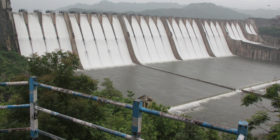In Pic :Pedestrians and visitors gather as smog envelopes The Red Fort in New Delhi. India’s air monitoring centre on May 8, 2014, has dismissed data released by the World Health Organisation that showed New Delhi’s air as among the dirtiest worldwide, saying the finding was biased and misleading
The air in New Delhi is more polluted than in Beijing, according to an international report that quantifies pollution levels, confirming findings by experts confounded by the lack of attention to the city’s problem.
The findings by the World Health Organization, released Wednesday, show the cities ranking second through fourth on the list are also in India, in the central Hindi belt, while the most polluted city on the planet turns out to be Peshawar in neighbouring Pakistan.
Thursday in New Delhi, air pollution monitors measured levels of PM 2.5 — the small particles considered among the most dangerous for lung health — at more than 350 micrograms per cubic metre of air. That is twice as high as Beijing’s peak for the morning, according to a post on a Twitter account about Beijing pollution maintained by the U.S. Embassy there.

PM 2.5 refers to particulate matter less than 2.5 micrometres in diameter, which is believed to pose the greatest health risk because it penetrates deeply into lungs.
For years, experts have wondered why so much international attention has focused on Beijing when some say conditions are equally as bad or even worse in South Asia.
“I am shocked at the extent of the problem they found in India,” said Dr. Sundeep Salvi, director of the Chest Research Foundation in Pune, India.
“This is incredibly bad, and there is a complete lack of awareness about it both amongst policy-makers and the common man.”

In Beijing, a pollution level as high as Delhi’s would most likely have caused widespread concern. But in Delhi, almost no one seemed to notice.
Few people here wear the filter masks that have been appearing on the streets of Beijing, and even among the wealthy, few own air purifiers that are used widely in East Asia — because few are even aware of the problem.






Leave a reply